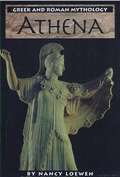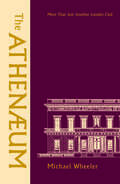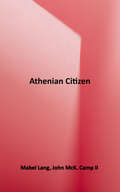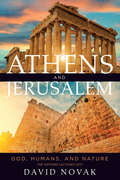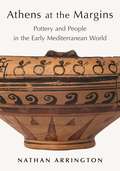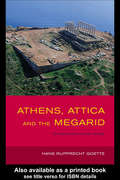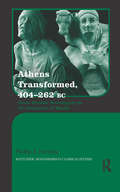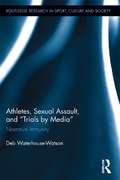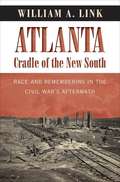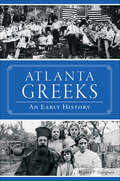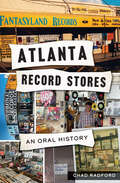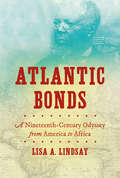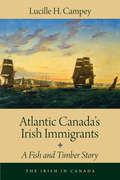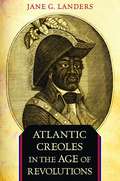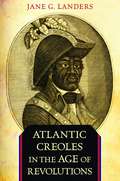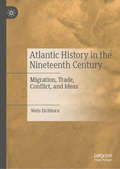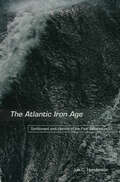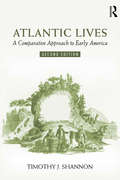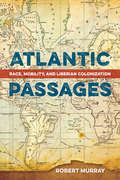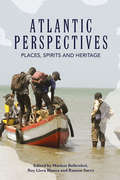- Table View
- List View
Athena (Greek and Roman Mythology)
by Nancy LoewenSurveys classical mythology, discussing the relationship between Greek and Roman myths, and describes the birth and life of the goddess Athena.
The Athenaeum: More Than Just Another London Club
by Michael WheelerA compelling history of the famous London club and its members&’ impact on Britain&’s scientific, creative, and official life When it was founded in 1824, the Athenæum broke the mold. Unlike in other preeminent clubs, its members were chosen on the basis of their achievements rather than on their background or political affiliation. Public rather than private life dominated the agenda. The club, with its tradition of hospitality to conflicting views, has attracted leading scientists, writers, artists, and intellectuals throughout its history, including Charles Darwin and Matthew Arnold, Edward Burne-Jones and Yehudi Menuhin, Winston Churchill and Gore Vidal. This book is not presented in the traditional, insular style of club histories, but devotes attention to the influence of Athenians on the scientific, creative, and official life of the nation. From the unwitting recruitment of a Cold War spy to the welcome admittance of women, this lively and original account explores the corridors and characters of the club; its wider political, intellectual, and cultural influence; and its recent reinvention.
The Athenian Citizen: Democracy in the Athenian Agora (Agora Picture Book #Book Four)
by Mabel Lang John McK. CampA concise introduction to the workings of ancient democracy, The Athenian Citizen has been a bestseller since the original edition was first published almost 60 years ago by Mabel Lang. Using archaeological evidence from excavations at the heart of ancient Athens, this volume shows how tribal identity was central to all aspects of civic life, guiding the reader through the duties of citizenship as a soldier in times of war and as a juror during the peace. <p><p>The checks and balances that protected Athenian society from tyrants, such as legal assassination and ostracism, are described. Selected inscriptions are illustrated and discussed, as are ingenious devices such as allotment machines and water clocks, which ensure fairness in the courts. The book ends with some of the lasting products of classical administration: the silver coins accepted around the known world and the standard weights and measures that continue to protect the consumer from unscrupulous merchants. <p><p>Illustrated entirely in color, with updates and revisions by the current director of excavations at the Agora, this edition of an acknowledged classic will inform and fascinate visitors and students for many years to come.
Athens after the Peloponnesian War: Class, Faction and Policy 403-386 B.C. (Routledge Revivals)
by Barry StraussHistorians are used to studying the origins of war. The rebuilding in the aftermath of war is a subject that – at least in the case of Athens – has received far less attention. Along with the problems of reconstructing the economy and replenishing the population, the problem of renegotiating political consensus was equally acute. Athens after the Peloponnesian War, first published in 1986, undertakes a radically new investigation into the nature of Athenian political groups. The general model of ‘faction’ provided by political anthropology provides an indispensable paradigm for the Athenian case. More widely, Professor Strauss argues for the importance of the economic, social and ideological changes resulting from the Peloponnesian War in the development of political nexus. Athens after the Peloponnesian War offers a detailed demographic analysis, astute insight into political discourse, and is altogether one of the most thorough treatments of this important period in the Athenian democracy.
Athens and Jerusalem: God, Humans, and Nature (The Kenneth Michael Tanenbaum Series in Jewish Studies)
by David NovakWhat is the relation of philosophy and theology? This question has been a matter of perennial concern in the history of Western thought. Written by one of the premier philosophers in the areas of Jewish ethics and interfaith issues between Judaism and Christianity, Athens and Jerusalem contends that philosophy and theology are not mutually exclusive. Based on the Gifford Lectures David Novak delivered at the University of Aberdeen in 2017, this book explores the commonalities and common concerns that exist between philosophy and theology on metaphysical, epistemological, and ethical questions. Where are they different and where are they the same? And, how can they speak to one another?
Athens at the Margins: Pottery and People in the Early Mediterranean World
by Nathan T. ArringtonHow the interactions of non-elites influenced Athenian material culture and societyThe seventh century BC in ancient Greece is referred to as the Orientalizing period because of the strong presence of Near Eastern elements in art and culture. Conventional narratives argue that goods and knowledge flowed from East to West through cosmopolitan elites. Rejecting this explanation, Athens at the Margins proposes a new narrative of the origins behind the style and its significance, investigating how material culture shaped the ways people and communities thought of themselves.Athens and the region of Attica belonged to an interconnected Mediterranean, in which people, goods, and ideas moved in unexpected directions. Network thinking provides a way to conceive of this mobility, which generated a style of pottery that was heterogeneous and dynamic. Although the elite had power, they were unable to agree on the norms of conspicuous consumption and status display. A range of social actors used objects, contributing to cultural change and to the socially mediated production of meaning. Historiography and the analysis of evidence from a wide range of contexts—cemeteries, sanctuaries, workshops, and symposia—offers the possibility to step outside the aesthetic frameworks imposed by classical Greek masterpieces and to expand the canon of Greek art.Highlighting the results of new excavations and looking at the interactions of people with material culture, Athens at the Margins provocatively shifts perspectives on Greek art and its relationship to the eastern Mediterranean.
Athens, Attica and the Megarid: An Archaeological Guide
by Hans Rupprecht GoetteThis exciting new guide is the ideal companion to Greece if you are a traveller with historical and archaeological interests, as it combines practical information with impeccable scholarly research.Written by an expert on Greece's landscape and archaeology, the guide is unique in exploring a wide range of sites off the beaten track. It also tours all the best-known monuments and regions, from the Acropolis to Aegina, from Megara to Marathon and from Sounion to Salamis.Beautifully illustrated with over 200 plates, maps, plans and drawings, it includes:* precise descriptions of routes and individual sites* artistic, historical, social and political background* unprecedented coverage outside Athens* detailed exploration of the post-classical, Byzantine and post-Byzantine periods.Take it with you on your travels or read it at home; either way, you will gain a deeper appreciation and enjoyment of Greece's history and archaeology.
Athens Burning: The Persian Invasion of Greece and the Evacuation of Attica (Witness to Ancient History)
by Robert Garland“A fresh approach to the Greco-Persian wars focusing on Athens’s evacuation, Persian occupation, and rebuilding . . . [a] compelling book.” —John O. Hyland, Christopher Newport UniversityWinner of the Choice Outstanding Academic TitleBetween June 480 and August 479 BC, tens of thousands of Athenians evacuated, following King Xerxes’ victory at the Battle of Thermopylae. Abandoning their homes and ancestral tombs in the wake of the invading Persian army, they sought refuge abroad. During this difficult year of exile, the city of Athens was set on fire not once, but twice. In Athens Burning, Robert Garland explores the reasons behind the decision to abandon Attica, the peninsular region of Greece that includes Athens, while analyzing the consequences, both material and psychological, of the resulting invasion.Taking its inspiration from the sufferings of civilians, Athens Burning also works to dispel the image of the Persians as ruthless barbarians. Addressing questions that are largely ignored in other accounts of the conflict, including how the evacuation was organized and what kind of facilities were available to the refugees along the way, Garland demonstrates the relevance of ancient history to the contemporary world. This compelling story is especially resonant in a time when the news is filled with the suffering of nearly 5 million people driven by civil war from their homes in Syria. Aimed at students and scholars of ancient history, this highly accessible book will also fascinate anyone interested in the burgeoning fields of refugee and diaspora studies.“The fullest account of the Persian sack of Athens in September 480 and in June 479 BCE available in English.” —Canadian Journal of History
Athens Transformed, 404-262 BC: From Popular Sovereignty to the Dominion of Wealth (Routledge Monographs in Classical Studies)
by Phillip HardingDuring the heady, democratic days of the fifth and fourth centuries, the poorer members of Athenian society, the lower two classes of zeugitai and thetes, enjoyed an unprecedented dominance in both domestic and foreign politics. At home, the participatory nature of the constitution required their presence not only in the lawcourts and assembly, but also in most of the minor magistracies; abroad, they were the driving force of the navy, which ensured Athens’ control of the Aegean and the Black seas. Their participation at all levels was made possible by state pay (for jury duty, attendance in the assembly, public office and military service). In the fifth century state pay was financed largely through the tribute paid by members of the empire, supplemented by the liturgical contributions of the rich and, beginning during the war, a property tax (the eisphora). In the fourth century, almost the whole burden was shouldered by taxation upon the wealthy, especially those who owned property. In this book, author Phillip Harding traces the major changes that occurred in the administration of the state that eventually deprived the lower classes of their supremacy and transferred power into the hands of the wealthy land-owners. Things changed radically after Athens’ defeat in the Lamian (or Hellenic) War in 322BC. Over the next several decades, restriction of the franchise, elimination of pay for some public offices, the loss of the navy, the increased dependence upon local grain from the larger estates in Attika, the removal of the tax burden from the rich by the ending of such major liturgies as the trierarchia and the choregia and the abandoning of the eisphora all contributed to this transformation.
Athletes, Sexual Assault, and Trials by Media: Narrative Immunity (Routledge Research in Sport, Culture and Society #22)
by Deb Waterhouse-WatsonSince footballer sexual assault became top news in 2004, six years after the first case was reported, much has been written in the news media about individual cases, footballers and women who have sex with them. Deb Waterhouse-Watson reveals how media representations of recent sexual assault cases involving Australian footballers amount to "trials by media", trials that result in acquittal. The stories told about footballers and women in the news media evoke stereotypes such as the "gold digger", "woman scorned" and the "predatory woman", which cast doubt on the alleged victims’ claims and suggest that they are lying. Waterhouse-Watson calls this a "narrative immunity" for footballers against allegations of sexual assault. This book details how popular conceptions of masculinity and femininity inform the way footballers’ bodies, team bonding, women, sex and alcohol are portrayed in the media, and connects stories relating to the cases with sports reporting generally. Uncovering similar patterns of narrative, grammar and discourse across these distinct yet related fields, Waterhouse-Watson shows how these discourses are naturalised, with reports on the cases intertwining with broader discourses of football reporting to provide immunity. Despite the prevalence of stories that discredit the alleged victims, Waterhouse-Watson also examines attempts to counter these pervasive rape myths, articulating successful strategies and elucidating the limitations built into journalistic practices, and language itself.
Atlanta, Cradle of the New South
by William A. LinkAfter conquering Atlanta in the summer of 1864 and occupying it for two months, Union forces laid waste to the city in November. William T. Sherman's invasion was a pivotal moment in the history of the South and Atlanta's rebuilding over the following fifty years came to represent the contested meaning of the Civil War itself. The war's aftermath brought contentious transition from Old South to New for whites and African Americans alike. Historian William Link argues that this struggle defined the broader meaning of the Civil War in the modern South, with no place embodying the region's past and future more clearly than Atlanta. Link frames the city as both exceptional--because of the incredible impact of the war there and the city's phoenix-like postwar rise--and as a model for other southern cities. He shows how, in spite of the violent reimposition of white supremacy, freedpeople in Atlanta built a cultural, economic, and political center that helped to define black America.
Atlanta Greeks: An Early History (American Heritage Ser.)
by Stephen P. GeorgesonBy 1890, the first Greek immigrants to Atlanta had settled into an area still widely populated by Confederate veterans. In a city without the large immigrant presence common in the nation's major urban areas, the Greeks were initially received as undesirable visitors by the state's and city's leaders. While the Greek Orthodox Church of Atlanta endured financial hardship, it continued to aid funerals, hospitals and orphanages. These Greeks moved from the city's streets as fruit vendors into more established businesses. Christ Gyfteas's fruit stand at the corner of Broad and Marietta became the California Fruit Company. By 1911, 40 percent of Greeks were proprietors or partners in a variety of businesses like cafés, restaurants, soda fountains and groceries. Author Stephen Georgeson explores the Greek immigrants' experiences in their first three decades in Atlanta.
Atlanta Pop in the '50s, '60s & '70s: The Magic of Bill Lowery
by Andy Lee White Williams M JohnDiscover the people and places that made Atlanta the pop music capital of the United States in the second half of the twentieth century.Former DJ Bill Lowery attracted a galaxy of talent and created an empire of music publishing, production and promotion. In 1956, the Lowery Music Company had its first million copy-selling hit single with &“Be-Bop-a-Lula,&” by Gene Vincent. Under Lowery&’s direction, popular artists like Tommy Roe and Billy Joe Royal flourished. Audio engineer Rodney Mills teamed up with Lowery and future Atlanta Rhythm Section manager Buddy Buie to build Studio One, a recording studio that produced albums from legendary acts such as Joe South, Lynyrd Skynyrd, 38 Special and others. Andy Lee White and John M. Williams offer a comprehensive portrait of the vibrant postwar Atlanta music scene.&“Insight and memories from major behind the scenes figures like engineer, producer and Georgia Music Hall of Fame member, Rodney Mills (Lynyrd Skynyrd, Atlanta Rhythm Section, Gregg Almond, Joe South) along with Bob &“Tub&” Langford (engineer for Joe South&’s biggest hits and Lynyrd Skynyrd&’s &“Freebird&”) help tell previously untold memories from a special time for Atlanta music like none before or since.&” —East Cobber
Atlanta Record Stores: An Oral History
by Chad RadfordAtlanta Record Stores is an oral history of the city's rock music scene, as witnessed through the lens of Criminal Records, Fantasyland, Wax 'N' Facts, and many more. This is a rock-centric take on a town that's so often praised and admired around the world as a hip-hop mecca. Here, the secret history of the underdogs--outsiders living among outsiders--are told. From Jarboe of SWANS to William DuVall of Alice In Chains and Neon Christ, to Kelly Hogan, and those surly guys behind the counter at Wuxtry, all were drawn by the irresistible lure of vinyl records, all found their communities and their own identities, leaving an indelible mark on the culture of Atlanta. Now, in their own voices, their stories are told.
Atlantic Bonds: A Nineteenth-Century Odyssey from America to Africa (H. Eugene and Lillian Youngs Lehman Series)
by Lisa A. LindsayA decade before the American Civil War, James Churchwill Vaughan (1828–1893) set out to fulfill his formerly enslaved father's dying wish that he should leave America to start a new life in Africa. Over the next forty years, Vaughan was taken captive, fought in African wars, built and rebuilt a livelihood, and led a revolt against white racism, finally becoming a successful merchant and the founder of a wealthy, educated, and politically active family. Tracing Vaughan's journey from South Carolina to Liberia to several parts of Yorubaland (present-day southwestern Nigeria), Lisa Lindsay documents this "free" man's struggle to find economic and political autonomy in an era when freedom was not clear and unhindered anywhere for people of African descent.In a tour de force of historical investigation on two continents, Lindsay tells a story of Vaughan's survival, prosperity, and activism against a seemingly endless series of obstacles. By following Vaughan's transatlantic journeys and comparing his experiences to those of his parents, contemporaries, and descendants in Nigeria and South Carolina, Lindsay reveals the expansive reach of slavery, the ambiguities of freedom, and the surprising ways that Africa, rather than America, offered new opportunities for people of African descent.
Atlantic Bonds: A Nineteenth-Century Odyssey from America to Africa (H. Eugene and Lillian Youngs Lehman Series)
by Lisa A. LindsayA decade before the American Civil War, James Churchwill Vaughan (1828–1893) set out to fulfill his formerly enslaved father's dying wish that he should leave America to start a new life in Africa. Over the next forty years, Vaughan was taken captive, fought in African wars, built and rebuilt a livelihood, and led a revolt against white racism, finally becoming a successful merchant and the founder of a wealthy, educated, and politically active family. Tracing Vaughan's journey from South Carolina to Liberia to several parts of Yorubaland (present-day southwestern Nigeria), Lisa Lindsay documents this "free" man's struggle to find economic and political autonomy in an era when freedom was not clear and unhindered anywhere for people of African descent. In a tour de force of historical investigation on two continents, Lindsay tells a story of Vaughan's survival, prosperity, and activism against a seemingly endless series of obstacles. By following Vaughan's transatlantic journeys and comparing his experiences to those of his parents, contemporaries, and descendants in Nigeria and South Carolina, Lindsay reveals the expansive reach of slavery, the ambiguities of freedom, and the surprising ways that Africa, rather than America, offered new opportunities for people of African descent.
Atlantic Canada's Irish Immigrants: A Fish and Timber Story
by Lucille H. CampeyA transformative work that explodes assumptions about the importance of the Great Irish Potato Famine to Irish immigration. In this major study, Lucille Campey traces the relocation of around ninety thousand Irish people to their new homes in Atlantic Canada. She shatters the widespread misconception that the exodus was primarily driven by dire events in Ireland. The Irish immigration saga is not solely about what happened during the Great Potato Famine of the 1840s; it began a century earlier. Although they faced great privations and had to overcome many obstacles, the Irish actively sought the better life that Atlantic Canada offered. Far from being helpless exiles lacking in ambition who went lemming-like to wherever they were told to go, the Irish grabbed their opportunities and prospered in their new home. Campey gives these settlers a voice. Using wide-ranging documentary sources, she provides new insights about why the Irish left and considers why they chose their various locations in Nova Scotia, New Brunswick, Prince Edward Island, and Newfoundland. She highlights how, through their skills and energy, they benefitted themselves and contributed much to the development of Atlantic Canada. This is essential reading for anyone wishing to understand the history of the Irish exodus to North America and provides a mine of information useful to family historians.
Atlantic Creoles In The Age Of Revolutions
by Jane LandersSailing the tide of a tumultuous era of Atlantic revolutions, a remarkable group of African-born and African-descended individuals transformed themselves from slaves into active agents of their lives and times. Through prodigious archival research, Jane Landers radically alters our vision of the breadth and extent of the Age of Revolution, and our understanding of its actors.
Atlantic Creoles in the Age of Revolutions
by Jane G. LandersSailing the tide of a tumultuous era of Atlantic revolutions, a remarkable group of African-born and African-descended individuals transformed themselves from slaves into active agents of their lives and times. Big Prince Whitten, the black Seminole Abraham, and General Georges Biassou were “Atlantic creoles,” Africans who found their way to freedom by actively engaging in the most important political events of their day. These men and women of diverse ethnic backgrounds, who were fluent in multiple languages and familiar with African, American, and European cultures, migrated across the new world’s imperial boundaries in search of freedom and a safe haven. Yet, until now, their extraordinary lives and exploits have been hidden from posterity. Through prodigious archival research, Jane Landers radically alters our vision of the breadth and extent of the Age of Revolution, and our understanding of its actors. Whereas Africans in the Atlantic world are traditionally seen as destined for the slave market and plantation labor, Landers reconstructs the lives of unique individuals who managed to move purposefully through French, Spanish, and English colonies, and through Indian territory, in the unstable century between 1750 and 1850. Mobile and adaptive, they shifted allegiances and identities depending on which political leader or program offered the greatest possibility for freedom. Whether fighting for the King of Kongo, England, France, or Spain, or for the Muskogee and Seminole chiefs, their thirst for freedom helped to shape the course of the Atlantic revolutions and to enrich the history of revolutionary lives in all times.
Atlantic Crossroads in Lisbon’s New Golden Age, 1668–1750 (Iberian Encounter and Exchange, 475–1755)
by Cacey Bowen FarnsworthLong dependent on the Asian spice trade, Portugal suffered serious setbacks during the period of political union with Spain (1580–1640), as the Dutch and others seized key regions and destroyed commercial monopolies. By 1668, the greatest hope for a renewed Portuguese empire lay to the west. This book examines the “Atlanticization” of Lisbon during the early modern era, investigating the social, economic, religious, and political evolution that took place in Portugal’s capital during a period of upheaval and transformation in Europe and in the Atlantic world.In this book, Cacey Bowen Farnsworth shows how, between 1668 and 1750, Lisbon became a crossroads where colonial developments intermingled with metropolitan and global influences to produce something novel among European port capitals. Drawing from extensive primary and secondary sources from Portugal, Brazil, England, France, and Spain, Farnsworth lays out how Lisbon’s transformations were generated in commercial exchanges, especially the slave trade, as well as in the often-tense arrangements between the British and the Portuguese, and he shows how social, economic, cultural, and religious transformations made Lisbon a unique center of encounter.Responding to valid criticisms of Atlantic history, Farnsworth’s history of early modern Lisbon demonstrates that historians do not always have to defer to a global lens of analysis. It is sure to be of value to any researcher interested in early modern Iberia, commerce, and globalism.
Atlantic History in the Nineteenth Century: Migration, Trade, Conflict, and Ideas
by Niels EichhornThis book argues that a vibrant, ever-changing Atlantic community persisted into the nineteenth century. As in the early modern Atlantic world, nineteenth-century interactions between the Americas, Africa, and Europe centered on exchange: exchange of people, commodities, and ideas. From 1789 to 1914, new means of transportation and communication allowed revolutionaries, migrants, merchants, settlers, and tourists to crisscross the ocean, share their experiences, and spread knowledge. Extending the conventional chronology of Atlantic world history up to the start of the First World War, Niels Eichhorn uncovers the complex dynamics of transition and transformation that marked the nineteenth-century Atlantic world.
The Atlantic Iron Age: Settlement and Identity in the First Milennium BC
by Jon HendersonFirst Published in 2008. Routledge is an imprint of Taylor & Francis, an informa company.
Atlantic Lives: A Comparative Approach to Early America
by Timothy ShannonAtlantic Lives offers insight into the lived experiences of a range of actors in the early modern Atlantic World. Organized thematically, each chapter features primary source selections from a variety of non-traditional sources, including travel narratives from West Africa, the Caribbean, and Latin America. The fully-revised and expanded second edition goes into even greater depth in exploring the diverse roles and experiences of women, Native Americans, and Africans, as well as the critical theme of emerging capitalism and New World slavery. New chapters also address captivity experiences, intercultural religious encounters, and interracial sexuality and marriage.With classroom-focused discussion questions and suggested additional readings accompanying each chapter, Atlantic Lives provides students with a wide-ranging introduction to the many voices and identities that comprised the Atlantic World.
Atlantic Passages: Race, Mobility, and Liberian Colonization
by Robert MurrayEstablished by the American Colonization Society in the early nineteenth century as a settlement for free people of color, the West African colony of Liberia is usually seen as an endpoint in the journeys of those who traveled there. In Atlantic Passages, Robert Murray reveals that many Liberian settlers did not remain in Africa but returned repeatedly to the United States, and he explores the ways this movement shaped the construction of race in the Atlantic world.Tracing the transatlantic crossings of Americo-Liberians between 1820 and 1857, in addition to delving into their experiences on both sides of the ocean, Murray discusses how the African neighbors and inhabitants of Liberia recognized significant cultural differences in the newly arrived African Americans and racially categorized them as “whites.” He examines the implications of being perceived as simultaneously white and black, arguing that these settlers acquired an exotic, foreign identity that escaped associations with primitivism and enabled them to claim previously inaccessible privileges and honors in America.Highlighting examples of the ways in which blackness and whiteness have always been contested ideas, as well as how understandings of race can be shaped by geography and cartography, Murray offers many insights into what it meant to be black and white in the space between Africa and America.
Atlantic Perspectives: Places, Spirits and Heritage
by Markus Balkenhol Ruy Llera Blanes Ramon SarróFocusing on mobility, religion, and belonging, the volume contributes to transatlantic anthropology and history by bringing together religion, cultural heritage and placemaking in the Atlantic world. The entanglements of these domains are ethnographically scrutinized to perceive the connections and disconnections of specific places which, despite a common history, are today very different in terms of secular regimes and the presence of religion in the public sphere. Ideally suited to a variety of scholars and students in different fields, Atlantic Perspectives will lead to new debates and conversations throughout the fields of anthropology, religion and history.
